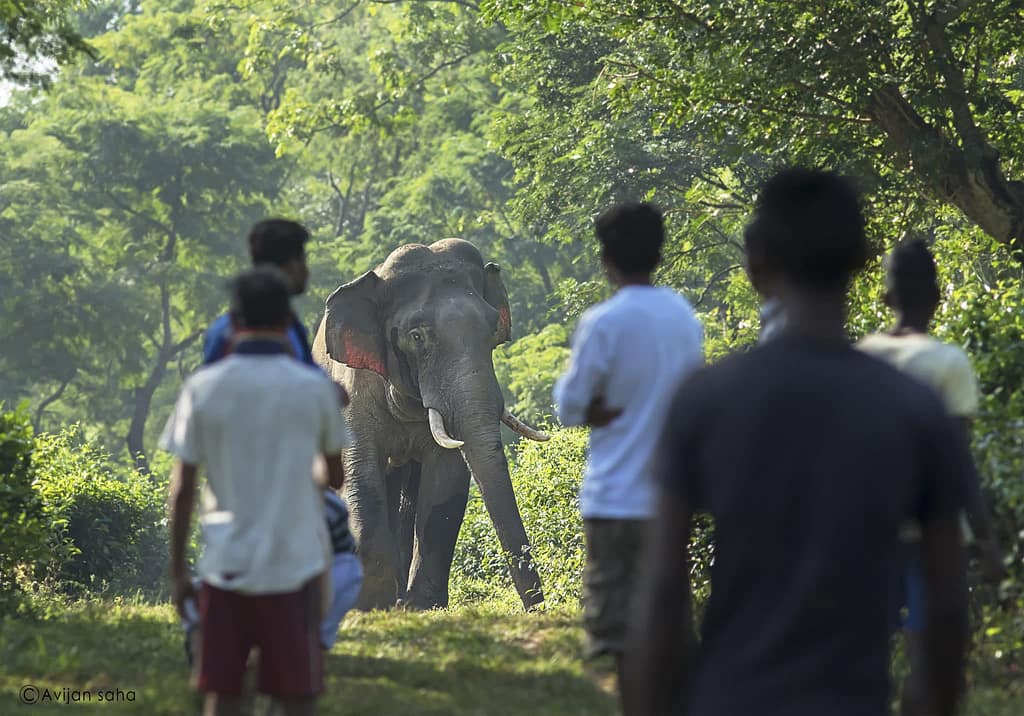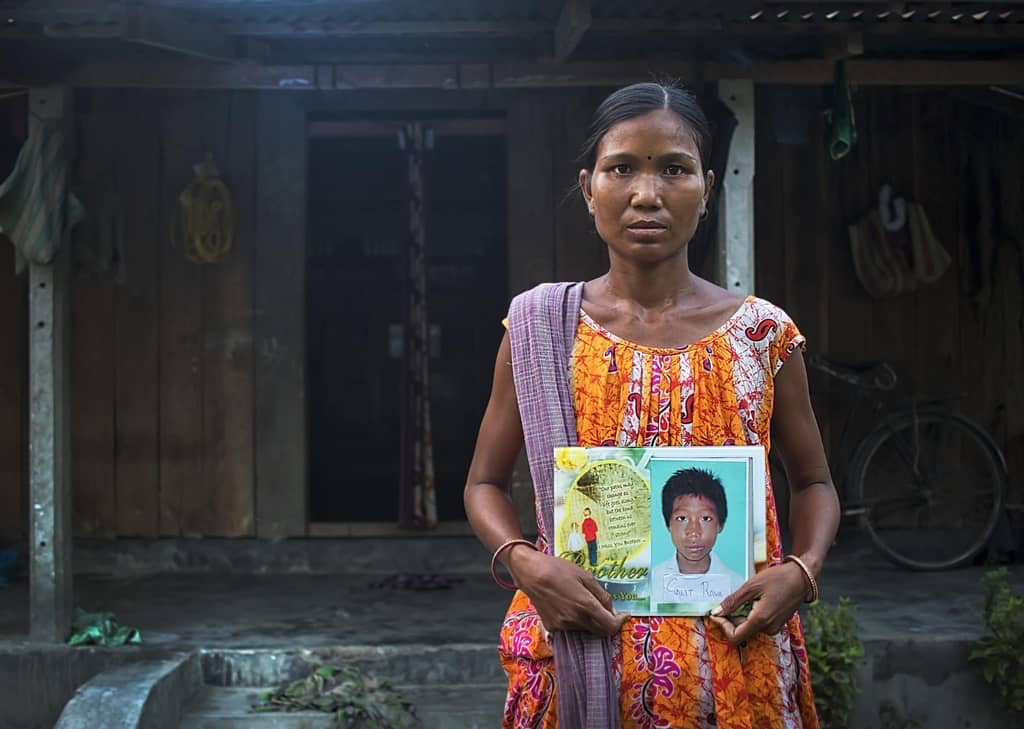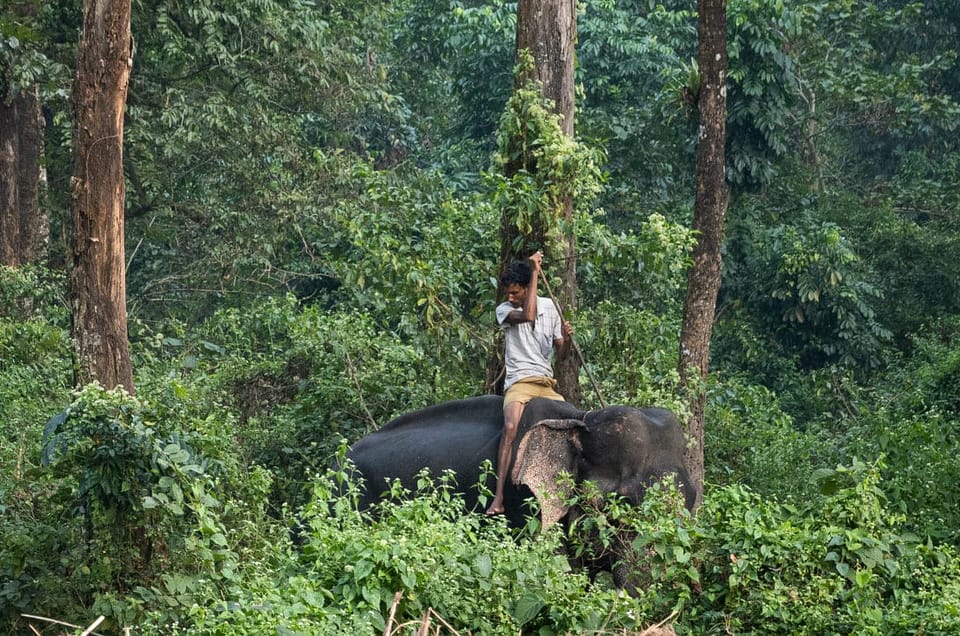documenting the human-elephant conflict along the India-Nepal border
PHOTOGRAPHER AVIJAN SAHA HAS DEVOTED THE PAST SIX YEARS TO DOCUMENTING THE HUMAN-ELEPHANT CONFLICT ALONG THE MECHI RIVER REGION IN NORTHERN INDIA, IDENTIFYING SOLITARY BULLS AND MIGRATING ELEPHANTS ON THE INDIA-NEPAL BORDER, AND DOCUMENTING HOW THEIR BEHAVIORS ARE SHIFTING AND ADAPTING DUE TO SHRINK- ING HABITAT. SINCE 2017, AVIJAN HAS BEEN COLLABORATING WITH WRITER KIM FRANK, A FELLOW OF THE EXPLORERS CLUB SINCE 2018, AND NATIONAL GEOGRAPHIC PHOTOGRAPHER JODY MACDONALD AS PART OF A COMPREHENSIVE HUMAN-ASIAN ELEPHANT CONFLICT PROJECT: RESEARCHING ISSUES, ENGAGING WITH REGIONAL STAKEHOLDERS, OBTAINING GOVERNMENT FOREST ACCESS, AND DOCUMENTING FACETS OF THE HUMAN-ELEPHANT RELATIONSHIP IN NORTHERN INDIA. THE PROJECT IS DESIGNED TO RAISE AWARENESS AMONG A WESTERN AUDIENCE OF THE UNIQUE CONSERVATION ISSUES FACED BY ASIAN ELEPHANTS AND THE HUMANS WHO LIVE AMONG THEM.

Long revered in Hindu culture as a manifestation of one of its most important deities, Ganesha, the elephant is both worshiped and feared. Killing an elephant is considered an odious crime, made illegal by decree as early as 300 bc by the Indian Emperor Chandragupta, author of one of the first known wildlife protection edicts. Officially recognized as India’s National Heritage Animal, the elephant is given the strictest level of protection under the law. Yet for all this reverence, elephants and humans are increasingly engaged in deadly clashes, resulting in an average death toll of 400 humans and 100 elephants in the region annually. India is home to the largest number of wild Asian elephants in the world, estimated at 27,312 in 2017, about 55 percent of the species’ global population. These sophisticated Goliaths roam throughout 29 elephant reserves spread over ten elephant landscapes in 14 states, covering approximately 65,814 square kilometers of habitat in northeast, central, northwest, and south India. While this may seem like a vast amount of territory, elephant reserves include multiple areas of human use and habitation. And, according to a recent study by the Wildlife Trust of India, unless they lie within existing forest reserves or the protected area network, elephant reserves are not legally protected habitats in and of themselves. Elephants, by nature, are in constant motion, migrating over approximately 350 to 500 square kilometers annually through a suite of habitats that have traditionally encompassed dense mountains, open grasslands, and the jungles of northern India, from Assam to Bhutan and Nepal. Today, however, this once lush landscape has rapidly given way to human encroachment, particularly along the Mechi River, which winds through the borderlands of Nepal and India—an important elephant migratory corridor where only scant patches of forest remain.

29 elephant reserves spread over ten elephant landscapes in 14 states, covering approximately 65,814 square kilometers of habitat in northeast, central, northwest, and south India. While this may seem like a vast amount of territory, elephant reserves include multiple areas of human use and habitation. And, according to a recent study by the Wildlife Trust of India, unless they lie within existing forest reserves or the protected area network, elephant reserves are not legally protected habitats in and of themselves.
elephants and humans are increasingly engaged in deadly clashes, resulting in an average annual death toll of 400 humans and 100 elephants in the region.
However, recent decades have seen an explosion in the refugee populations along the India-Nepal border, expansion of tea plantations and worker communities, increases in highway construction and train travel, and a reduction of nutrient-abundant forests. These changes are causing an unprecedented clash between humans and elephants, and the situation is approaching crisis level.
With their natural habitats dwindling, these elephants have changed their migration patterns to feed on what is now their most reliable food source: cultivated crops. In small villages and tea gardens throughout the migration route, crop season has become a mealtime calling card for elephant herds. Consequently, the height of the conflict coincides with two cultivation seasons: May-July for maize and October-December for rice. During these crop seasons, entire herds and solitary bulls raid food storage bins and destroy significant acreage, leaving damaged homes, injured and dead people in their wake as they seek food for their survival. In response, villagers and wildlife patrols sleep in specially built watchtowers, remaining alert through the night and early morning to stave off the elephants when they arrive. Officials use a variety of methods to deter elephants: firecrackers, clanging pots and pans, flashing bright lights on jeeps, and employing domesticated, specially trained elephants known as Kumkis to run off a wild herd. But, the elephants are savvy, determined and massive; often they are undeterred.
Across the border in Nepal, villagers used more aggressive methods, including shooting elephants as they marauded the crop fields. To protect both elephants and crops, in 2016 the Nepalese government, with support from the World Bank, erected a 17.5 km electric barrier fence named “Tarbar” to keep elephants from further depredation. While this solution has proven effective for the Nepalese, and saves elephants from possible death in that region, the unintended result is that elephants blocked from their traditional migratory routes now pool along border, heightening the crop plunder and human clashes on the Indian side. What was intended to be a safe solution to de-escalate deadly clashes in Nepal has led to increasing conflict for India, proving that even the best-intentioned tools utilized for conservation may have unintended consequences.

Avijan Saha, a photographer who has spent six years documenting the conflict, tells me multiple anecdotes of elephants changing their habits to survive: “This year, 137 elephants were gathered in Kolabari forest and changed their natural movement to scatter throughout nearby villages in the region. The fence has created many problems for this region and the elephants. The solitary bulls, for example, are attracted to certain areas. They study the human behav- ior and learn everything that is happening in each village. They are so intelligent that they can learn every person and that person’s daily routine, and then they move in when that person is gone.”
Saha shares photographs of particular males he has been studying. The bulls are the resident “bad boys,” lingering in the local landscape, continuously watching humans in the habitat. The herds are matriarchal, with only one breeding male bull serving as a protector and guide. Consequently, the other male elephants must leave the herd and live alone when they reach maturity. “The solitary bulls are now essentially sharing life with humans. People have harvested the diverse food supply that ele- phants need for survival. Only the loners are at a level to adapt to this situation, but the herds cannot adapt as easily and they suf- fer. Also, the loners are capable of breaking through the Nepal fencing, so there is a high risk of the tusker being poached.”
There seems to be no slowing of the rate of human inhabitation, further decreasing available land, and wildlife conservation organizations often feel they are fighting an uphill battle. Animesh Boush, founder and director of the Himalayan Nature and Adventure Foundation (HNAF), explains: “In North Bengal, the human population is exploding. Most of the people are coming from neighboring countries and states be- cause of political unrest. They are coming over into India from Bangladesh and Nepal. Most of the Mechi riverbed, including the elephant corridors, is now fragmented. The people have built their houses inside the landscape and the corridor is no longer free for elephants to pass.”

National Geographic photographer Jody MacDonald and I have spent long hours in the HNAF offices sharing tea, listening to stories about the elephants, and develop- ing strategies for our coverage of these issues. In May 2018, Boush encouraged us to seek permission to attend an elephant corridor stakeholder workshop being held in Darjeeling. Top government officials and NGOs, representatives from the Forest Department, conservation groups, tea plan- tations, railways, and the highway division in West Bengal and throughout northeast India convened to discuss strategies for mitigating the human-elephant conflict and enhance the migration corridors. No small feat, but their hearts and minds were fully committed. As the only Westerners in attendance, Jody and I were hesitantly included at first, and then wholly embraced. During dinners and tea breaks, there were many conversations with our new friends imploring us to help spread the message to a Western audience: that India reveres her elephants and needs understanding with focused support to help protect them.

This is a race against time. As India’s population continues to grow and land becomes exceedingly scarce, elephants are increasingly edged out of the flour- ishing habitats that are critical to their survival. Urgent efforts are underway to mitigate the conflict using every peaceful means one can conjure. Creative solutions to replenish natural corridors with green passageways under highways and over railways are being tested in the field, laws to protect people and elephants are being enforced, and new techniques are being developed. One promising solution is de- veloping swaths of nutrient-rich forested land barriers between human settlements and natural forests so elephants can restore their natural eating and roaming habits. But, the clock is ticking. With each elephant generation, new habits are being hardwired into the young elephants and they risk losing their organic knowledge of how to live in the forests. Still there is hope, as Ravikant Sinha, the Chief Wildlife Warden of West Bengal, whispered to us while on break at the Darjeeling workshop, “Elephants are smarter than humans. They will survive beyond us. Their intelligence is more powerful than we will ever fully com- prehend.” With four times more humans dying than elephants, Sinha appears to be correct. While elephants may be adapting more readily than humans, both sides stand to suffer irreparable loss if solutions are not put into action.
If you enjoyed this story, and would like to read more about exploration and conservation across the globe try out The Explorers Journal. Special thanks to Angela Schuster, TEJ Editor for her exceptional editing on this piece.































